

Project Brief Introduction:
1.Product:Dried Wood Log Pellet Line
2.Capacity:5-6 T/Hour
3.TONY Brand 5-6 Ton /Hour Dried Wood Log Pellet Line Project Process
4.Main Machine: Comprehensive Chipper,Hammer Mill,TONY Pellet MachineTYJ760-Ⅲ-160KW,Pellets Cooler,Packing Machine And Belt Conveyors
5.Total Power: About 600 kw
6.Need Area: About 448㎡ L: 28M W: 16M H: 6.517M
Project Layout For Customer:

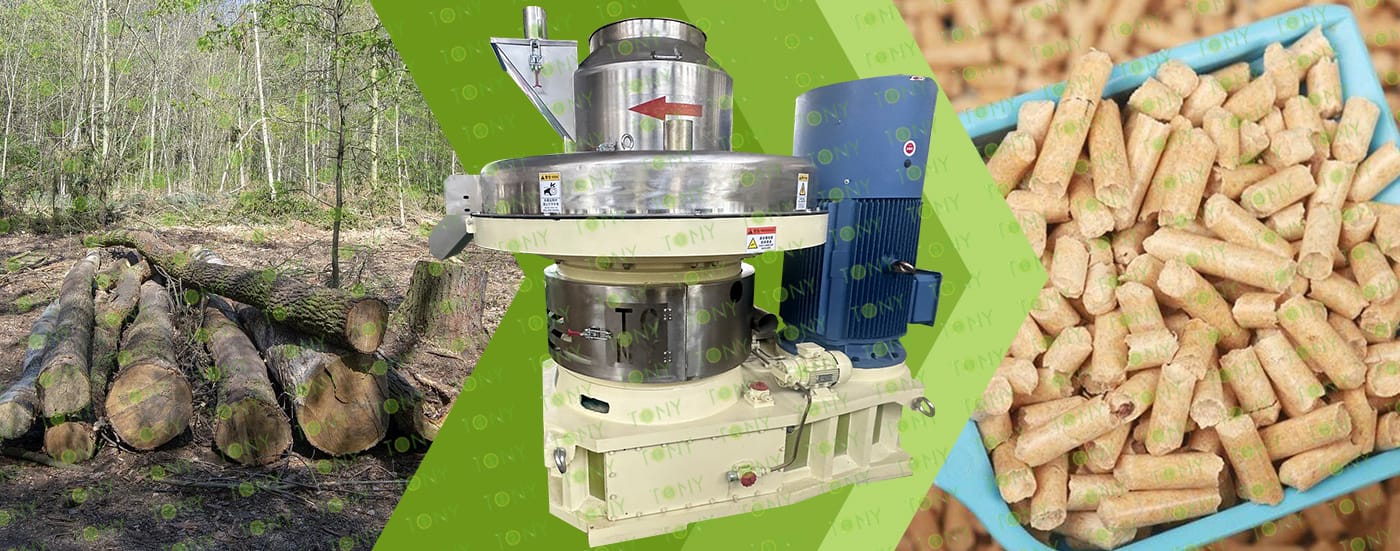
1. The working principle of dried wood log biomass pellet processing equipment
The working principle of dry wood biomass pellet fuel processing equipment is to convert dry wood waste (such as sawdust, shavings, wood scraps, etc.) into high-density, regularly shaped pellet fuel through a series of physical processing steps. The core relies on two major mechanisms: mechanical extrusion densification and natural bonding of lignin, without the addition of artificial adhesives.
2. Characteristics of dried wood log biomass pellet processing equipment
(1)Environmental protection and energy saving, in line with the concept of green production
Low pollution emissions: No wastewater is generated during the processing process. Only a small amount of waste gas may be generated during the drying process (if necessary), but it can be effectively purified by the supporting dust removal equipment (such as cyclone separators, bag dust collectors), which meets environmental protection standards.
Relatively low energy consumption: Since the raw materials are already dried, the high-energy-consuming deep drying process is eliminated; and the pelletizing process uses extrusion friction to generate heat, without the need for additional heating (or only auxiliary heating), and the overall energy consumption is lower than that of wet material processing equipment.
Outstanding environmental attributes of the product: The biomass pellet fuel produced has low carbon emissions when burned (approximately ""carbon neutral""), and the sulfur and nitrogen content is much lower than that of coal. It can replace fossil fuels, reduce environmental pollution, and contribute to the ""dual carbon"" goal.
(2) High degree of automation and easy operation and maintenance
Automatic control system: The complete set of equipment is usually equipped with a PLC control system, which can realize the linkage control of raw material transportation, feeding, pelletizing, cooling, screening and other links, and automatically monitor parameters such as raw material moisture content, pellet temperature, equipment load, etc., reducing manual intervention. Easy-to-maintain design: Core components (such as ring dies, rollers, and blades) are made of high-strength, wear-resistant materials (such as alloy steel) with a long service life. The modular structure makes it easy to disassemble, replace, and repair, reducing downtime and maintenance costs.
Complete safety protection: The equipment is equipped with safety devices such as overload protection, temperature alarm, and emergency stop button, which can effectively avoid damage caused by raw material impurities (such as metal blocks) or equipment failure, ensuring production safety.
3. Application scenarios of dried wood log biomass pellet processing equipment
Wood processing plants (such as furniture, wood flooring, and plywood factories) generate large quantities of dry sawdust, shavings, offcuts, and scraps during production. These waste materials have a low moisture content (typically ≤15% after natural air drying) and can be directly processed into pellet fuel through dry wood pellet processing without additional drying, thus achieving a ""waste-to-energy"" internal cycle:
(1)Self-use energy supply:
The pellets produced can be directly used in the factory's heating system (such as boilers and kilns), replacing traditional coal and natural gas, reducing energy costs (biomass pellets are typically 30%-50% cheaper than natural gas) and lowering carbon emissions.
(2)Reduced waste disposal costs:
Wood waste can be recycled through processing equipment, eliminating the need for waste accumulation and waste incineration (which can be polluting). Excess pellets can even be sold to generate additional revenue.

TONY Brand 5-6 Ton/Hour Dried Wood Log Pellet Manufacturing Plant can take dried wood, various types of wood - related biomass materials, such as branches, small - diameter logs, and wood shavings, with dried wood as the main raw material. After pretreatment and processing, it is solidified into high - density wood pellet fuel. This fuel is an ideal substitute for coal and oil and plays a role in energy conservation and emission reduction. At present, it has been widely used in regions rich in wood resources.
1. Capacity: 5-6Ton/Hour
2. Raw materials: Dried wood logs , branches, small - diameter logs, twigs, etc.
3. Moisture: Dried type, about 10-15%.
4. Application: All kinds of wood - based biomass materials suitable for pellet production.
Suitable customers: Green energy companies, forestry enterprises, and private wood - processing workshops that have advantages in wood raw materials.
5. Finished Pellets Markets: Large power plants ,domestic heating, industrial heating, combustion heat, heating systems, boiler rooms, school canteens, foundry heat sources.


1. Project Name: Dried Wood Log Pellet Production Line
2. Raw Material: All kinds of Dried wood log
3. Moisture Content of Raw Material: 10-15%
4. Capacity: 5-6 tons per hour
5. Process: Crushing Process - Fine Crushing Process - Pelletizing Process - Cooling Process - Packing Process
6. Main Equipment:Comprehensive Chipper TPC1000 - 90KW, Effective Hammer Mill-TFD75*160-160kw, TONY Pellet Machine TYJ760 - Ⅲ - 160kw, Pellet Cooler, Double Packing Machine and Belt Conveyors

|
How to use the TONY pellet production line to make pellets from dried wood log? The process mainly includes the following steps and equipment: 1. Use TONY comprehensive chipper to cut dried wood log with a diameter of less than 20 cm into wood chips 25 - 55 mm in length. 2. Use TONY effective hammer mill to crush the 25-55 mm wood chips into 8-14 mm sawdust. 3. Use TONY vertical ring die pellet machine to produce pellets with a diameter of 6-8 mm. 4. Use TONY galvanized cooler to cool the pellets from 80-90°C to 20-30°C. 5. Use TONY double packing machine to pack the pellets into bags, each weighing 15-50 kg. For more detailed information and quotations, you can contact TONY. TONY can provide all the above - mentioned products at highly competitive prices and with excellent quality. |
|
|||||||||||||||||||||||||||||||||||||||||||||
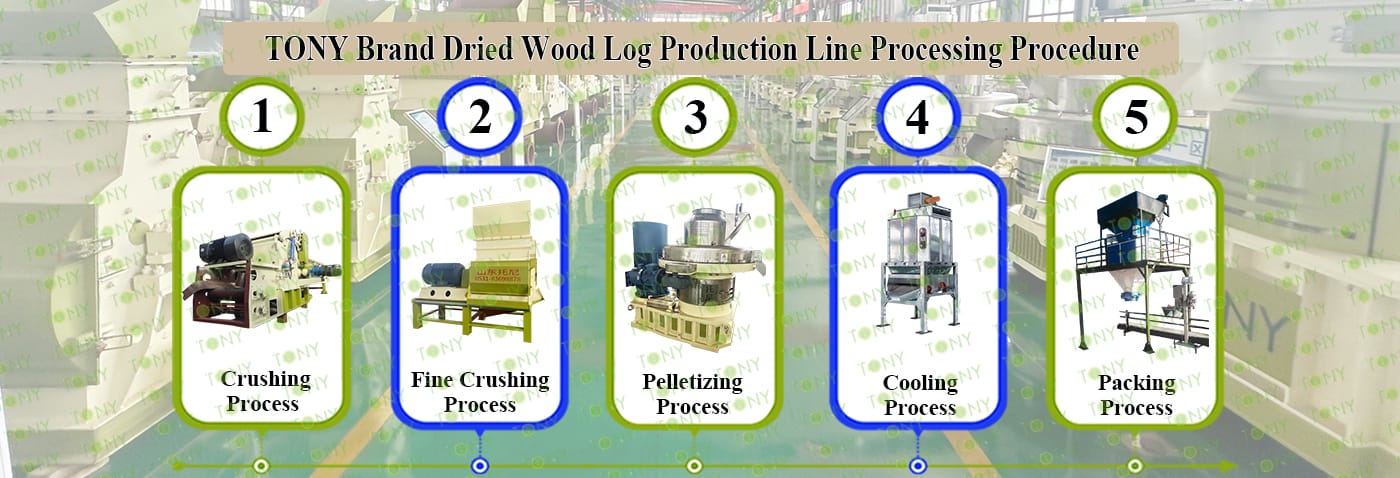
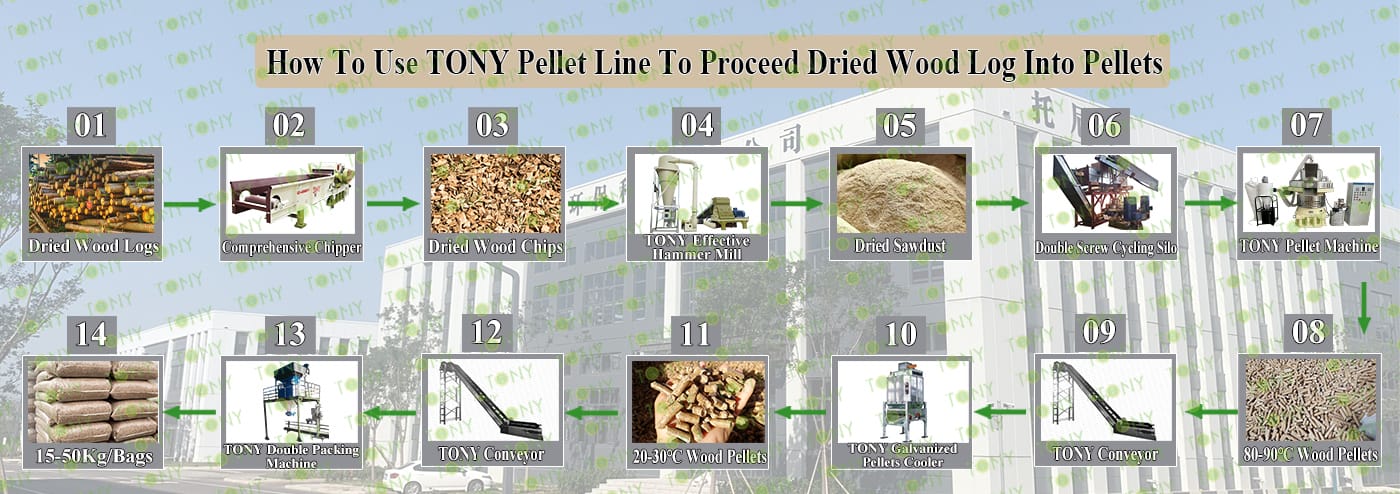

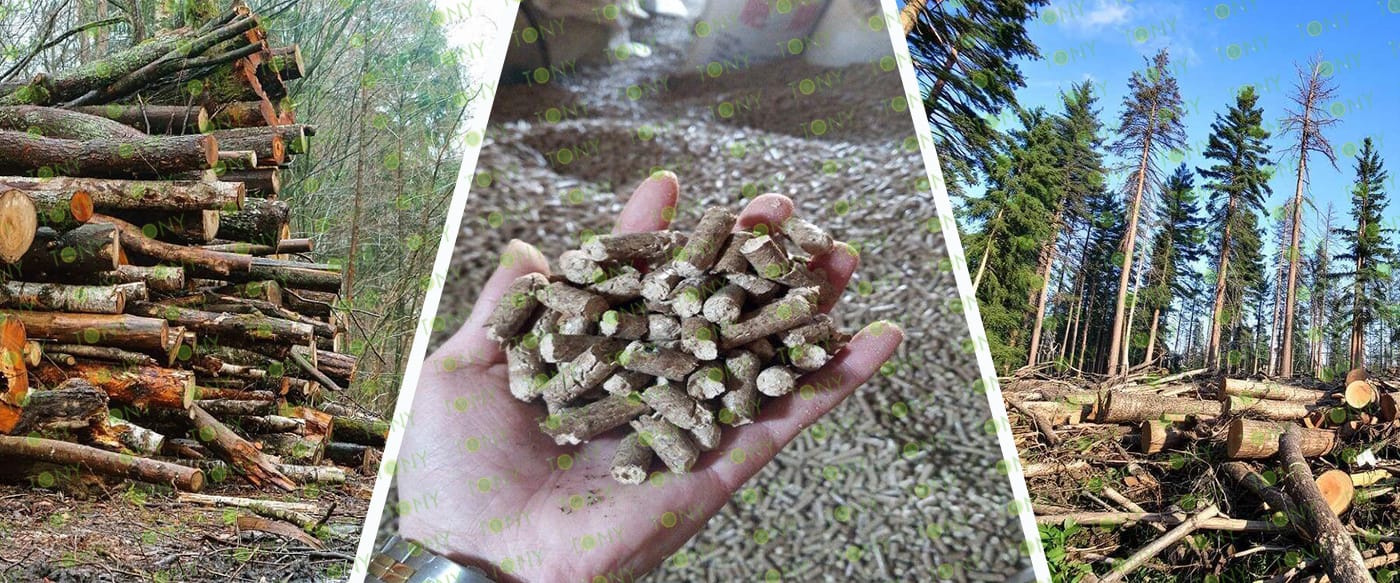

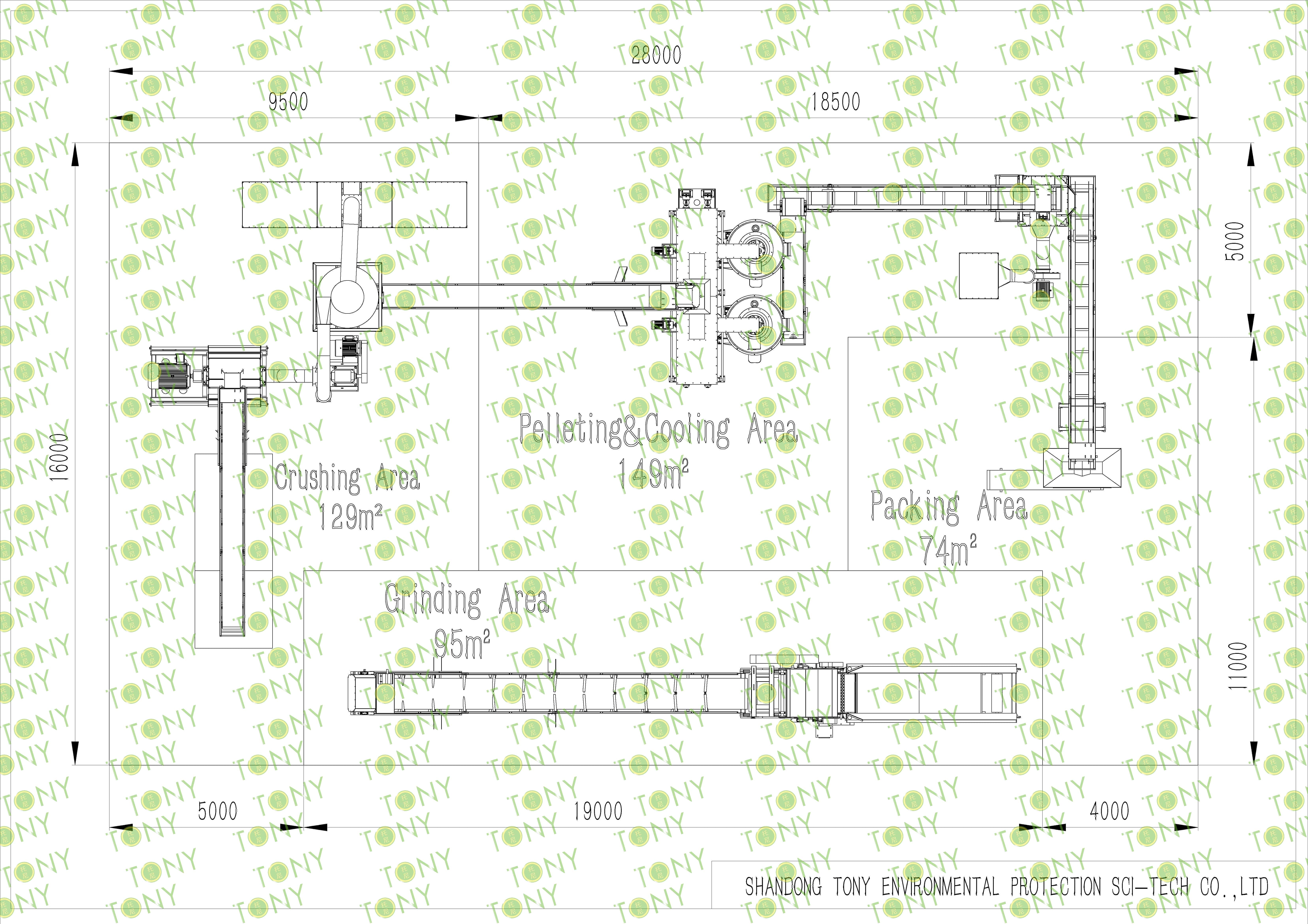
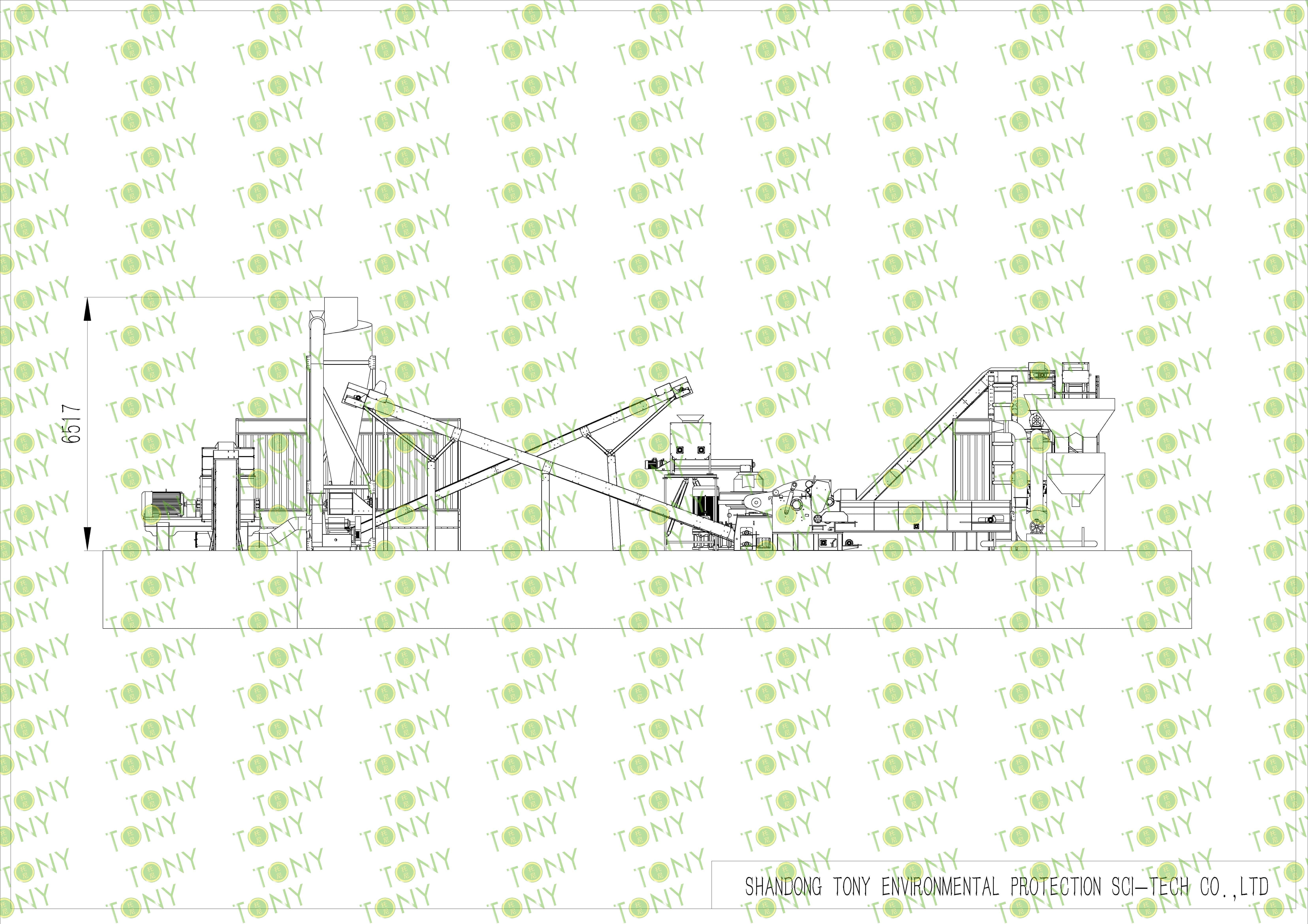
| Next, TONY Will Introduce To You All The Necessary Machinery That Will Be Used For The Whole Pellet Production Line. Some Machines Can Be Custom - Made By Customers According To Different Customers' Detailed Demands. Contact TONY For More Details, Including Quotation And Layout. | ||
 |
 |
 |
| Comprehensive Chipper | Effective Hammer Mill | Double Screw Cycling Silo |
|
1.To Grind Wood Logs φ ≤20cm Into25-55mm Wood Chips. 2.Model: TPC1000-90KW With 6 Baldes*1set 3.Capacity: 7-10Ton/Hour. |
1.To Crush 25-55mm Wood Chips Into 8-14mm Sawdust. 2.Model: TFD75*160-160KW*1set 3.Capacity: 5-6Ton/Hour/Set |
1.To Stroage Sawdust Before Pellet Machine; Adjust The Speed Of Sawdust Entering The Pellet Machine 2.Model: TLC-5*1set 3.Capacity:5-6Ton/Hour/Set |
 |
 |
 |
| Vertical Ring Die Sawdust Pellet Machine | Galvanized Pellets Cooler | Double Packing Machine |
|
1.To Press Dry Sawdust Into 6-8mm Biomass Pellets 2.Model: TYJ760-III-160KW*2 sets 3.Capacity:2.5-3Ton/Hour/Set 4.New 304SS Type |
1.To Cool Pellets From 80-90℃ Into 20-30℃ 2.Model: TCN-4*1set 3.Capacity:5-6Ton/Hour |
1.To Pack Pellets Into 15-50KG/Bags. 2.Model: TPZ-50*1set 3.Capacity: 5-6Ton/Hour |

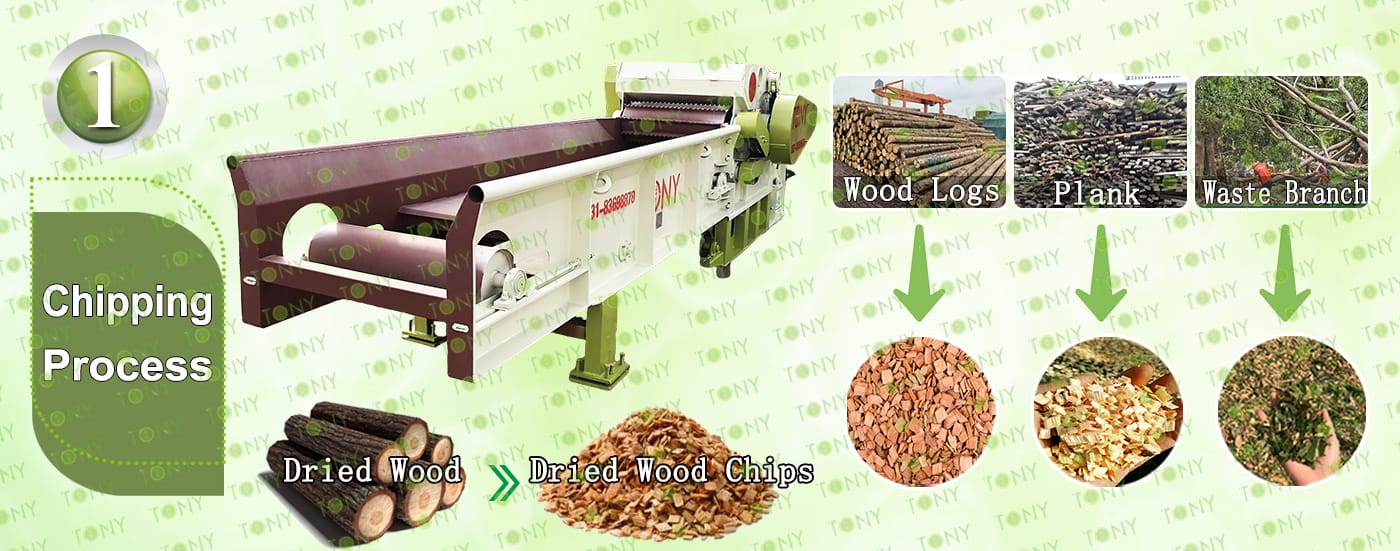
1.Wood Chipping Process:
A.This process is mainly used to grind the wood logs whose diamater is under 20cm into wood chips with size 25-55mm. The finish wood chips size can be adjustable by changing different sizes of screeners and adding flying knives inside the wood chipper.
B.TONY Brand TPC1000-90 kw model with 6flying blades type
C.Capacity:7-10Ton/Hour.
Main Parts:
(1)TONY's Comprehensive Chipper.
(2)Feed And Discharge Belt Frequency Control To Prevent Card Material
(3)Hydraulic System Control Can Be Used For Thicker Materials
(4)Electronic Control System Allows The Equipment To Be Used Normally
Contact Tony For More Details With Quotation


2.Wood Chips Fine Crushing Process:
A.This process is mainly used to crush 25-55mm wood chips into 8-14mm sawdust.
B.Capacity:5-6Ton/Hour.
C.TONY use effective hammer mill TFD75*160-160KW*1set
Main Parts:
(1)TONY Effective Hammer Mill.
(2)Galvanized Dust Collector.
(3)Sawdust Transportation Fan Blower.
(4)Cyclone With Airlock.
(5)Electrical Cabinets.

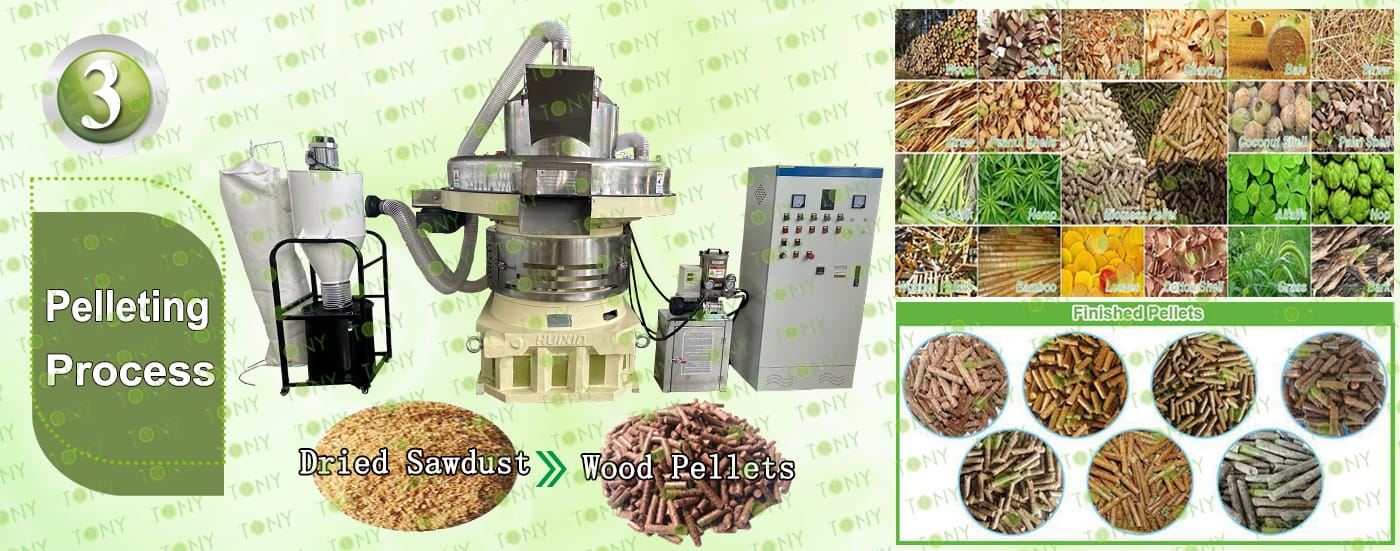
3.Pelletizing Process:
A.This process is mainly used to to product pellets into φ6-8mm.
B.Capacity:5-6Ton/Hour.
C.TONY Brand Vertical Ring Die Pellet Machine TYJ760-III-160KW*2Sets
D.Double Screw Cycling Silo is added above the pellet machine, which has the advantages of saving space, saving labor, intelligently controlling the feeding speed, not easy to block the material, and improving production efficiency.
Main Parts:
(1)TONY's New Vertical Ring Die Pellet Machine.
(2)Cyclone And Bags Dust Collectors.
(3)Automatic Lubrication System.
(4)Electrical Cabinets.
You can chose TONY new type SS304 pellet machine

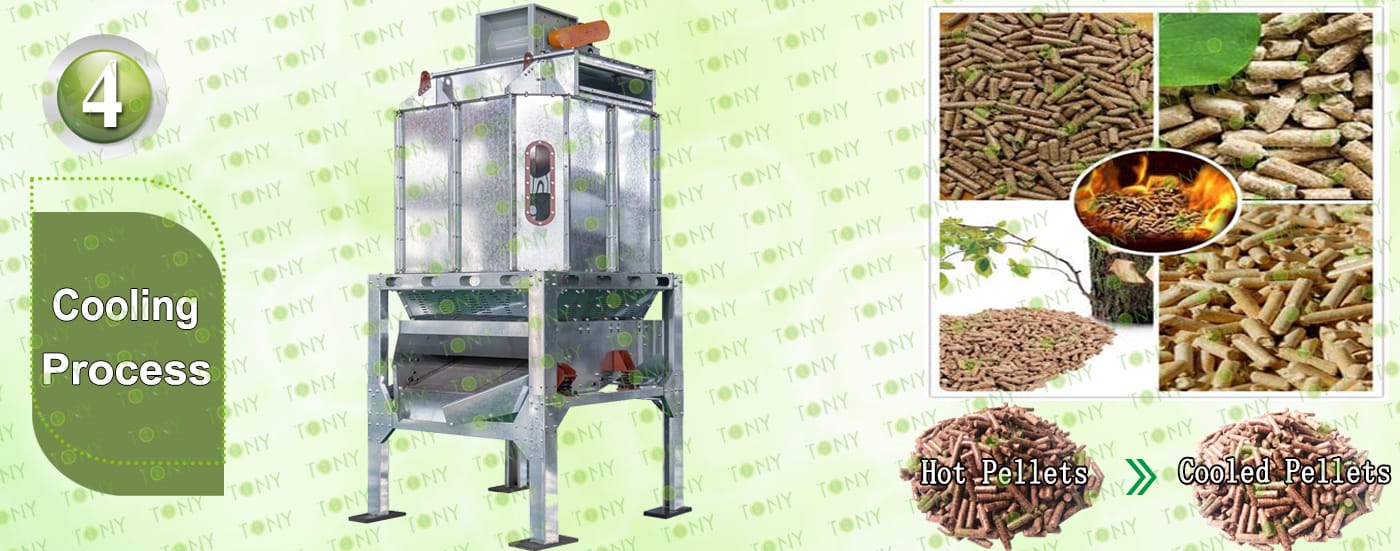
4.Cooling Process:
A.This process is mainly used to cool pellets from 80-90℃ to 20-30℃
B.1Set Of TONY Galvanized Cooler Seperator With Capacity 5-6 Ton/Hour
Main Parts:
(1)TONY's Galvanized Cooler Seperator With Vibrating Screen.
(2)Cyclone And Bags Dust Collectors.
(3) Fan Blower.
(4)Connect Pipes.

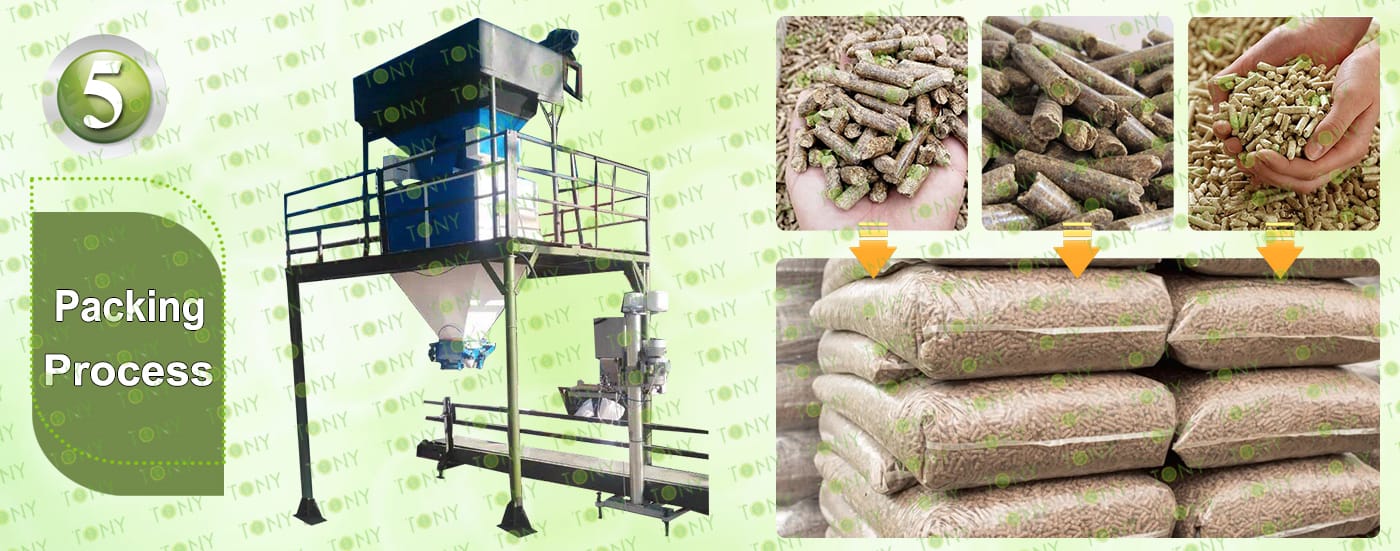
5.Packing Process:
A.This process is mainly used to pack pellets into 15-50KG/Bags.
B.1 Set of TONY Double Packing Machine.
Main Parts:
(1)TONY's Double Packing Machine.
(2)Sew Machine, Buyer Can Also Choose Hot Seal Machine For Chosen,To Confirm With Tony For The Price Difference.
(3)Bags Transportation Conveyors.
(4)Feeding Inlet Silo.
(5)Electrical Cabinets.



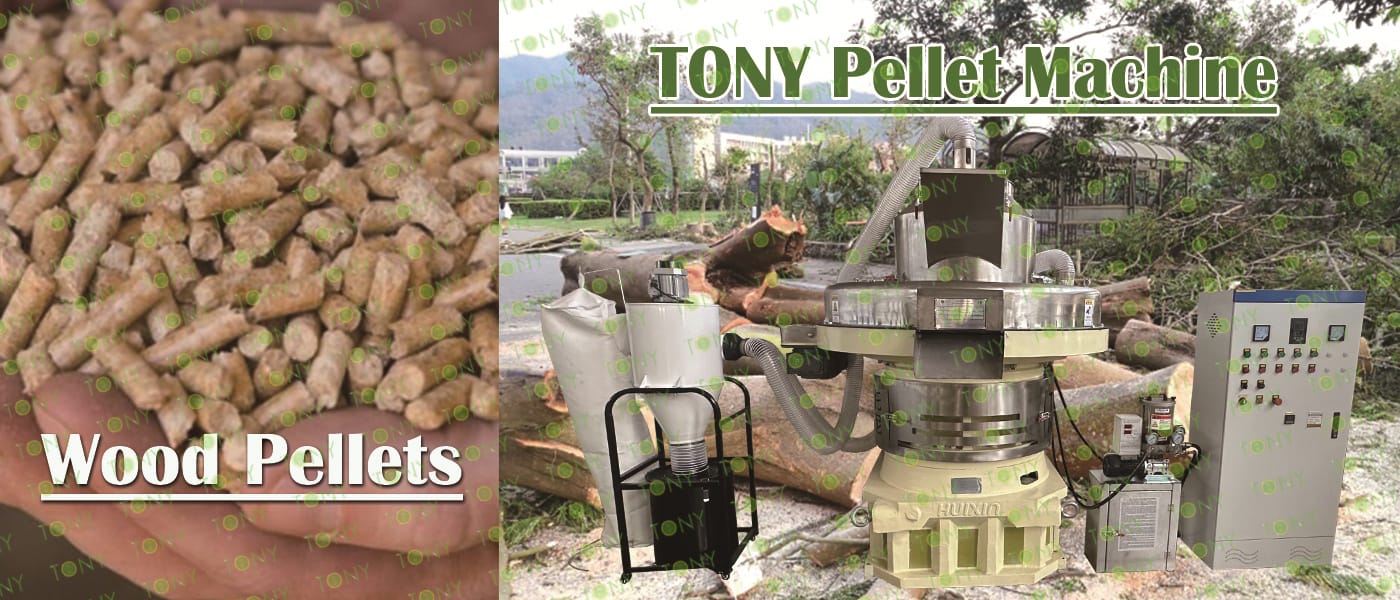
Processing dry wood into biomass pellets is a promising entrepreneurial venture. Here are its advantages and some key considerations:
1. Low Raw Material Cost:
Dry wood is widely available. Furniture factories, panel mills, sawmills, and other industries generate large quantities of scraps, shavings, and wood chips. In some areas, discarded wood can be obtained free of charge, effectively reducing raw material costs.
2. Stable Market Demand:
Biomass pellet fuel is environmentally friendly and renewable. In the residential sector, it can be used for home heating and is particularly popular in areas with high winter heating demand. Industrially, it can also be used as boiler fuel in factories, farms, and greenhouses. There is also significant demand for biomass pellets in some export markets.
3. Large Profit Margin:
The equipment pays for itself within 3-5 months, significantly increasing the added value compared to directly recycling dry wood.
4. Highly intelligent equipment:
Nowadays, some advanced pellet machines support PLC intelligent control and have the function of starting the entire line with one button. They have a high degree of automation and can generally be operated by two people. The difficulty and cost of human management are relatively low.

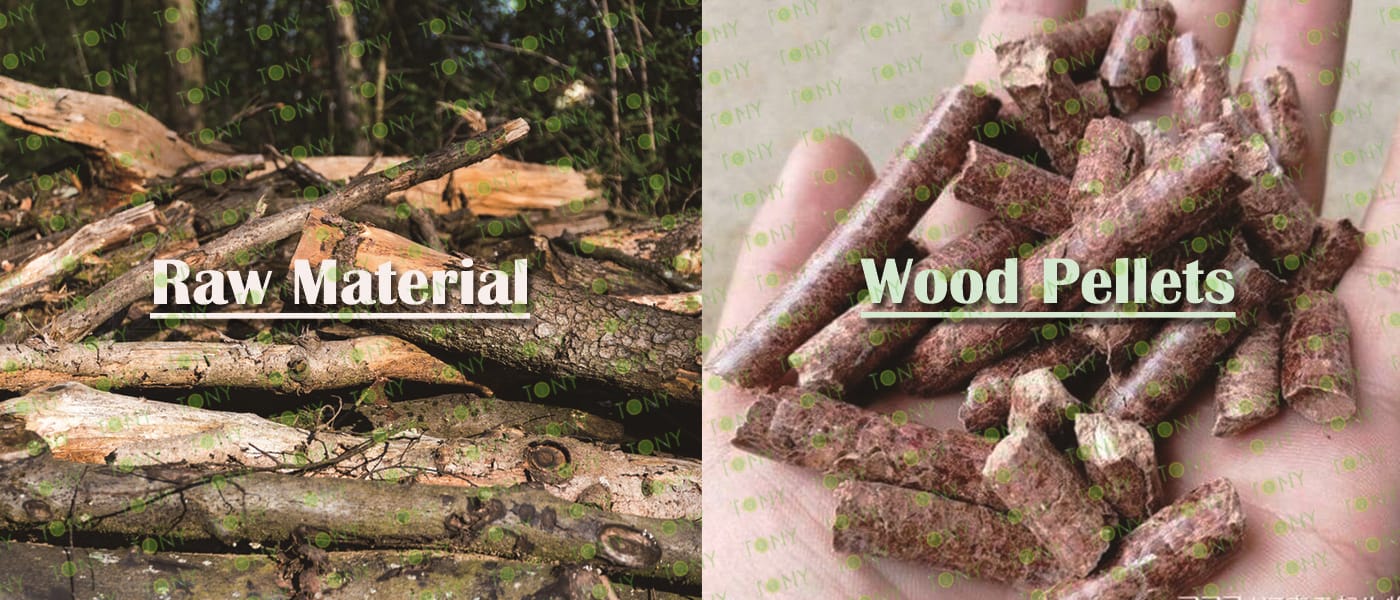
Wood pellets offer outstanding combustion performance and environmental advantages.
1. High and Stable Calorific Value
The calorific value of dry wood pellets is typically 4,000-4,500 kcal/kg (depending on the wood type; hardwoods like oak can reach 4,500 kcal, while softwoods like pine reach approximately 4,200 kcal). This is close to high-quality bituminous coal (4,500-5,500 kcal) and significantly higher than straw pellets (3,000-3,500 kcal).
2. Complete Combustion, Low Ash
Due to their high density and uniform structure, they provide ample air contact during combustion, achieving a complete burnout rate exceeding 95%. Residual ash is only 1%-3% (compared to approximately 5%-10% for straw pellets), reducing the need for frequent cleaning (industrial boilers can be cleaned every 10-15 days of continuous operation).
3. Easy to ignite, stable flame
Compared to raw coal, dry wood pellets are highly flammable (can be ignited with an open flame) and produce no deflagration or black smoke (high-quality pellets burn virtually smokelessly). Flame temperatures can reach 800-1000°C, making them suitable for applications requiring a stable heat source (such as food drying and industrial steam generation).
4. Low carbon emissions, nearly "carbon neutral"
The carbon dioxide absorbed during wood growth is roughly balanced by the amount released during combustion. Lifecycle carbon emissions are only 1/10 of those from coal, and nitrogen oxide emissions are over 50% lower than coal, meeting the requirements of the ""dual carbon"" policy.
5. Low pollutants
Sulfur content is ≤ 0.05% (compared to the typical 0.5%-3% for coal), and dust can be treated with simple collection devices.
6. Recyclable waste
The ash from combustion is rich in potassium, calcium, and other elements and can be returned to the fields as organic fertilizer, completing a closed ""fuel-ash-fertilizer"" cycle. It is particularly suitable for use in agricultural production areas.



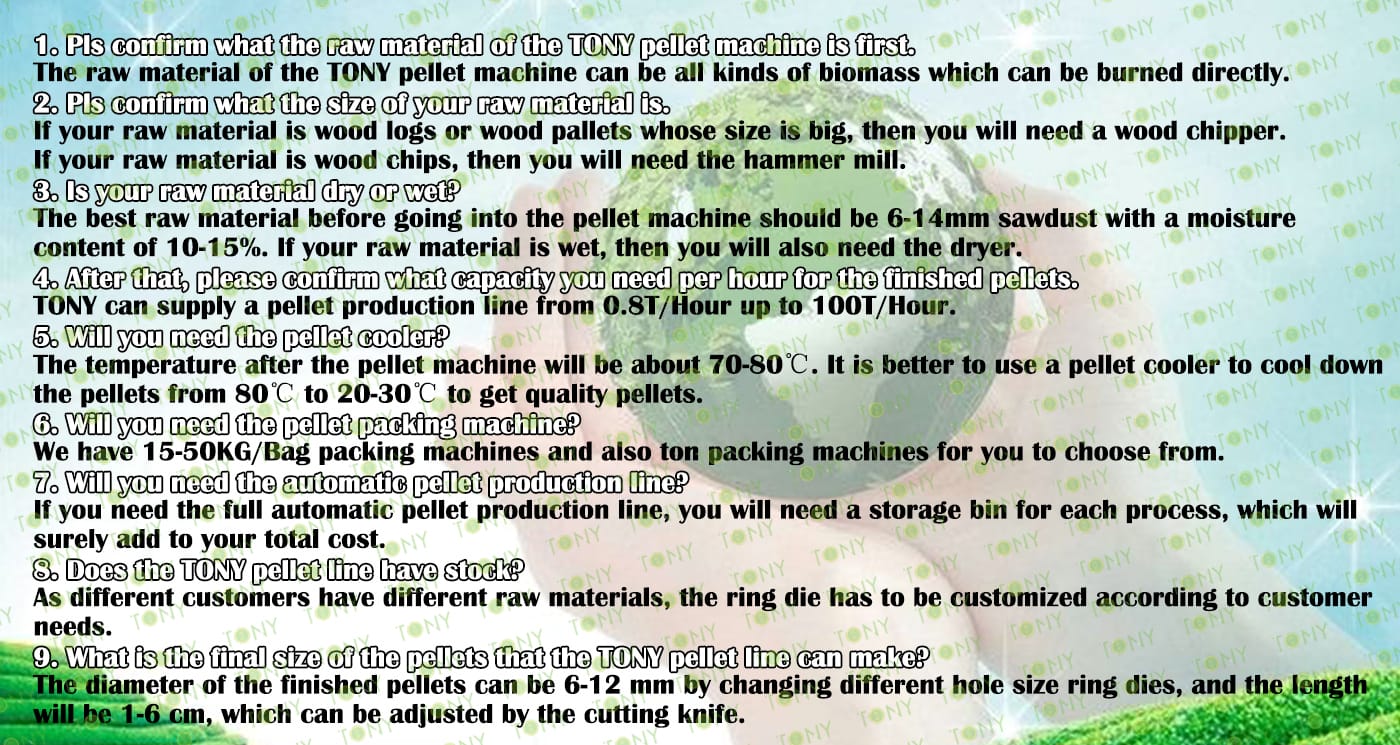

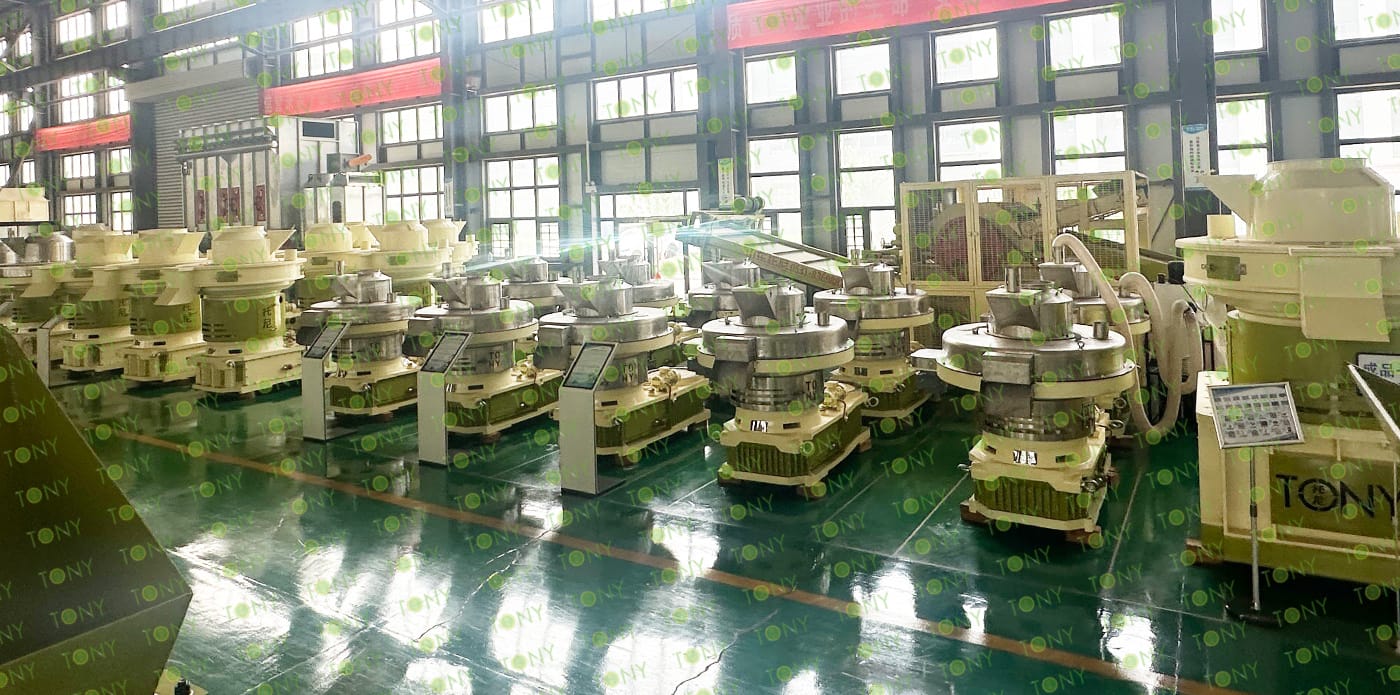
2025 Tony Machinery - All Rights Reserved. Map